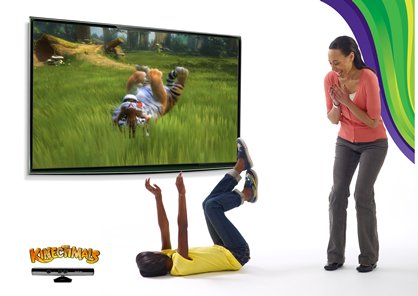Is Kinect shooting itself in its invisible foot?
Making something nobody asked for to appeal to a demographic that isn't listening - are you sure, Microsoft?
So, E3 has come and gone, and Microsoft has given Project Natal its final lick of paint. It is now Xbox Kinect, branded as the ultimate evolution of interactivity. With a great deal of pride, Microsoft asks the consumer, "Who thought that YOU would be the next Xbox 360 controller?" Who indeed? A more pertinent question may be, "Who thought that YOU being the next Xbox 360 controller was a good idea?"
Kinect looks great as a tech demo, and the lavish Cirque du Soleil extravaganza that unveiled it certainly introduced us to a bold and potentially exciting new concept. However, I fear that Microsoft, and indeed the public, aren't thinking very far ahead with Kinect. Just how much longevity does it have? Is there room for deep and involving gameplay? Most importantly, how is Kinect going to be able to entice the mainstream gamer in the same way that Nintendo's Wii has?

I have doubts about all three of those questions, having seen Kinect in action, and I fear that Microsoft's latest gimmick of invisible controllers is going to shoot itself in its invisible foot.
At first glance, Kinect appears to be a world of possibilities. A lack of controller, the recognition of an entire body's movement, it all looks like a realm crammed bursting with freedom and choice. That is, however, until you realize just how restrictive it is. The beauty of Kinect's interface is that it looks far more engaging than it actually is. When you sit back and think about it, the scope of what Kinect can do is incredibly limited.
There's a reason why the vast majority of Kinect titles we've seen so far are dancing games, minigames, and EyeToy knock-offs. It's because Kinect can't really handle anything else. The inability to conveniently make in-game characters walk forward already limits what the peripheral can do for gaming. One racing game has the player leaning forward in order to accelerate the car, but how long can you keep doing that before it becomes uncomfortable? That promising Star Wars game, otherwise known as the one title Microsoft will keep trotting out to convince us that Kinect isn't just for "TEH CASUALZ", requires the player to move forward in "bursts" by throwing their arms out. It may as well be on rails. A big deal has been made out of Child of Eden, but it's still on-rails and not really that hot looking. It's also coming to PlayStation Move, where I guarantee the controls will feel more precise and engaging.

On-rails gameplay is pretty much the body of Kinect's library from the looks of things, and there are only so many ways to make those types of games interesting. Having no buttons or joysticks sounds like a cool concept, but Microsoft underestimates exactly how crucial buttons are to the enjoyment of a game. Even the Nintendo DS has face buttons. The iPhone has only a touch screen, but who can argue that the iPhone is well suited for any game type other than weird puzzle games and five-minute oddities? I love the iPhone and I think it's an important gaming device, but the lack of actual buttons and sticks limits what it can do. The same goes for Kinect. Actually, I see Kinect being even more limited than the iPhone. At least the iPhone can mimic D-Pads and buttons, albeit in an unconventional and not always useful way. I dread to think about Kinect attempting to do the same.
Much of my time at E3 was spent watching sweaty game journalists play with Kinect. By the end of the week, I couldn't tell who was playing what. They were all doing the same things. Dancing around or jumping, while playing glorified EyeToy games. Microsoft has done a great job with the hype, but the delivery should fool only the most gullible of gamers. Show me a Halo or a Metal Gear Solid that can work better on Kinect than with a controller and I'll show you a horse that can ride a bicycle.

The simple fact is that real videogames aren't going to work with Kinect, and if a brave developer attempts one, it will most certainly be a simplified version, or a version that would just work better with a real controller.
We've already seen how Microsoft's ambitious plans for Kinect have been scaled back. Remember back at E3 2009, when players were shown steering cars with their hands and slamming their feet on invisible breaks? Yeah, where was that game at E3 2010? It wasn't there because Microsoft has had to consistently scale back its ideas. The Kinect of 2010 is significantly less exciting than the Project Natal of 2009, and it's because, from the very beginning, the product was more idea than substance.
Sign up to the GamesRadar+ Newsletter
Weekly digests, tales from the communities you love, and more


